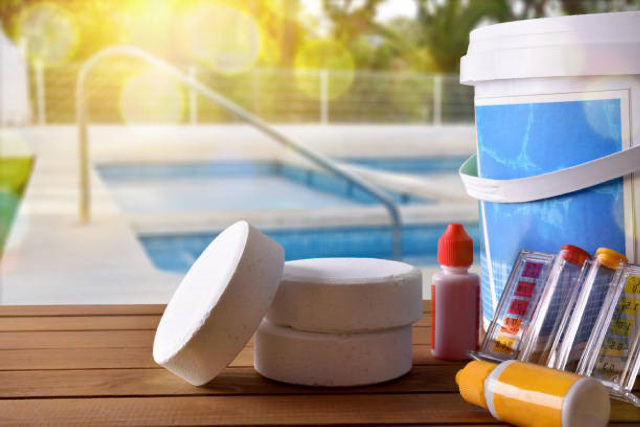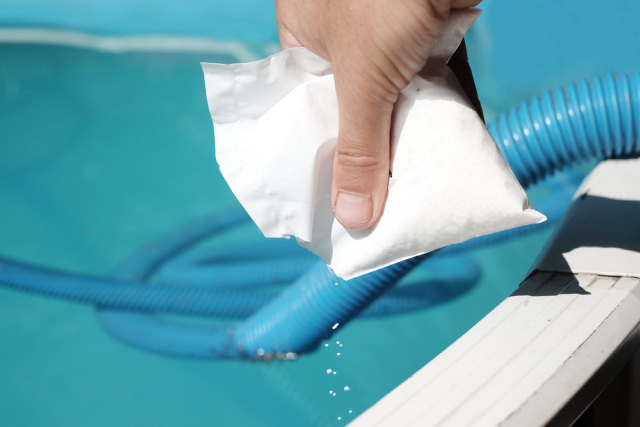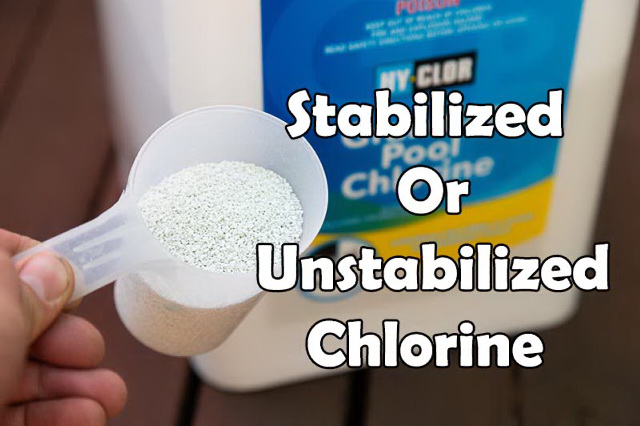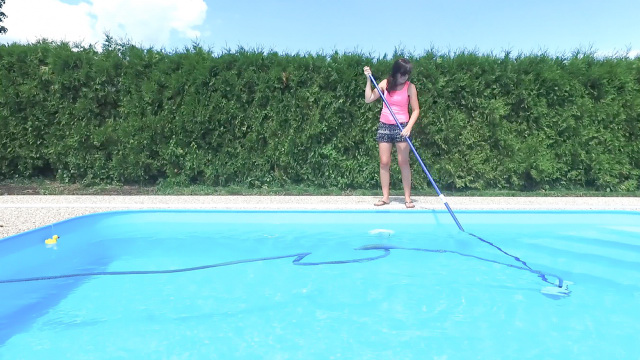Chlorine comes in several forms, such as stabilized versus unstabilized. You have some stabilized chlorine handy, and you’re wondering if you can use it to shock your pool. Will it work like regular chlorine?

Never shock a swimming pool with stabilized chlorine. Doing so risks too high levels of cyanuric acid (stabilizer) in your pool. This reduces the ability of the chlorine to sanitize both when shocking and after you’ve shocked the pool.
If you aren’t quite sure what pool shock or stabilized chlorine is, or how they work, don’t worry, as we’ll tell you everything you need to know in this guide. Make sure you keep reading so you can safely and successfully shock your pool the first time!
Article Contents
What Is Stabilized Chlorine?
First, let’s take the next two sections to talk about stabilized and unstabilized chlorine, beginning with the stabilized variety. As the name suggests, stabilized chlorine is regular chlorine with a stabilizer added. It reduces the effects of UV rays on chlorine.
That stabilizer is cyanuric acid, an industrial chemical often used in herbicides, disinfectants, and bleach. It’s white and has no odor. TriChlor and DiChlor are two very well-known examples of stabilized chlorine.
A stabilizer is necessary and recommended for all outdoor pools. But only to a point. You must manage your pool’s cyanuric acid levels because if you don’t, they can increase to a high degree which reduces the chlorine efficiency and potency.
Recommended levels of stabilizer are 30-50 ppm. If your stabilizer levels go above 60 or 70 ppm, you’ll need to reduce it. The only solution to reduce stabilizer levels is to drain some water and refill the water to dilute it. If your stabilizer levels are creeping up, discontinue the use of stabilized chlorine for a while and switch to unstabilized.
What Is Unstabilized Chlorine?
Okay, so that’s stabilized chlorine, but what about unstabilized chlorine?

As a pool owner, you’re probably much more familiar with unstabilized than stabilized chlorine, even if you don’t necessarily know it. Technically, unstabilized chlorine is any chlorine that doesn’t use cyanuric acid as a stabilizer. That can include powdered chlorine, granular chlorine, the list goes on and on.
Common unstabilized chlorines include liquid chlorine, bleach (Clorox), and calcium hypochlorite (cal-hypo).
Without a stabilizer present in your pool’s water, unstabilized chlorine has a much shorter life, so to speak. The UV rays from sunlight will break down the chlorine faster, leaving it ineffective.
You can always fix the issue with more chlorine, but that means going through your supply faster and spending more money as a result. The real solution is to make sure you have a sufficient level of stabilizer in your pool’s water (30-50 ppm).
Why You Shouldn’t Use Stabilized Chlorine to Shock a Pool
Between stabilized and unstabilized chlorine, the former sounds to you like it’s a whole lot better to use to shock a swimming pool, especially if you live in a very bright, sunny region.
Well, just because it sounds good in theory doesn’t make it suitable in practice. As we talked about in the first section, when you use copious amounts of stabilized chlorine as required when shocking a pool, you load the pool water up with cyanuric acid.
Cyanuric acid stabilizes chlorine, but it can also render it ineffective when there’s too much in the pool water. You want to keep the stabilizer levels under 50-60 ppm.
You’ll think you’re shocking your pool, but all you’re doing is making the chlorine ineffective. Now you have two problems to deal with, and you’re out a lot of money because you spent it on stabilized chlorine.
What Chlorine Should You Use to Shock a Pool?

You’re glad you know not to use stabilized chlorine to shock your pool, but you still have to do it, and that means you need some viable form of chlorine. Indeed, you do.
Here are the recommended unstabilized chlorines to shock your pool:
Liquid Chlorine Shock (Sodium Hypochlorite)
Liquid chlorine is also called sodium hypochlorite. Comprised of salt, water, and chlorine, the liquid variety is a frequent solution for sanitizing swimming pools. It’s also a great unstabilized chlorine for shocking your pool.
You simply pour some of the contents of the jug into a cup and then distribute that amount of chlorine directly into the water.
You may need several gallons of chlorine to shock a pool, but this form of chlorine is typically inexpensive enough that you won’t mind stocking up. But don’t stock up too much because liquid chlorine has a short shelf life.
Calcium Hypochlorite Shock
The next type of unstabilized chlorine we recommend for shocking a pool is calcium hypochlorite. When sodium hydroxide and chlorine meet in a solution, calcium hypochlorite results.
Calcium hypochlorite is considered a heavier-duty sanitizer than your standard liquid chlorine. It’s much stronger. And it’s what most products sold as “pool shock” contain.
It’s good for shocking because you can get the job done without a lot of product, unlike liquid chlorine, which will require several gallons. Be aware that too much shock can cause the pool to go cloudy, but that’s short term.
Non-Chlorine Shock
Okay, so technically, non-chlorine shock doesn’t include chlorine, but we wanted to include it here anyway since it’s such a viable means of shocking your swimming pool.
This product works like an oxidizer, removing dead skin, oil, sweat, and other contaminants from your pool. If your pool contains deodorant, lotion, and inorganic matter, non-chlorine shock can also begin breaking that down.
If you’re curious about non-chlorine shock and chlorine shock, check out our article.
Is Chlorine Stabilizer the Same as Shock?
Chlorine stabilizer and pool shock or chlorine shock aren’t the same at all.
Chlorine stabilizer, is a chemical (cyanuric acid aka CYA) designed to stabilize the chlorine from UV light so it lasts longer in the pool. In the water, chlorine stabilizer keeps the pool clean for longer than unstabilized chlorine.
Stabilizer (cyanuric acid) can be purchased separately or you can buy chlorine with stabilizer added.
Pool Shock is an unstabilized chlorine product (usually calcium hypochlorite aka cal-hypo) designed to rid the pool water of contaminants.
Can You Shock a Pool After Adding Cyanuric Acid (Stabilizer)?
You’ve just added stabilizer to your pool water. You also want to shock your pool Is it OK to add shock after you’ve added stabilizer (cyanuric acid) to the water?
If the CYA/Stabilizer levels tested over 60 ppm, do not shock your pool. Lower the stabilizer levels to the acceptable range first, which is 30-50 ppm. After that, it’s OK to shock your pool.
Whilst there is no danger of shocking your pool with high stabilizer levels. It just means the chlorine won’t be anywhere near as effective and you’ll need a lot more chlorine to get the job done.
Tips for Shocking Your Pool

You’ve got the right product to shock your pool, so now it’s time to get started. Here are some brief steps to guide you through the process.
Tip 1 – Wait Until Later in the Day
Since shock doesn’t contain a stabilizer, to prevent the sunlight from burning off the chlorine shock, plan to shock your pool later in the day after the sun sets.
Scheduling the shock at this time also allows you to enjoy your pool the next morning in most cases.
Tip 2 – Skim the Pool & Brush the Walls/Floor
You don’t need anything lingering on the surface of your swimming pool when trying to shock, so grab your skimmer and clean all surface debris like dirt, bugs, and leaves.
You don’t need to give your pool the deepest cleaning, but again, the fewer surface messes around, the more pristine your pool will be after shocking.
Tip 3 – Balance Pool pH Levels
You need to keep your pool pH balanced the entire time you shock, or the shock won’t work as effectively as it can. Do what’s necessary to balance the pH before you start shocking.
Tip 4 – Leave Overnight
Your pool pump must be turned on when shocking. The pump should run for the next 12 hours to disperse the shock throughout the water.

